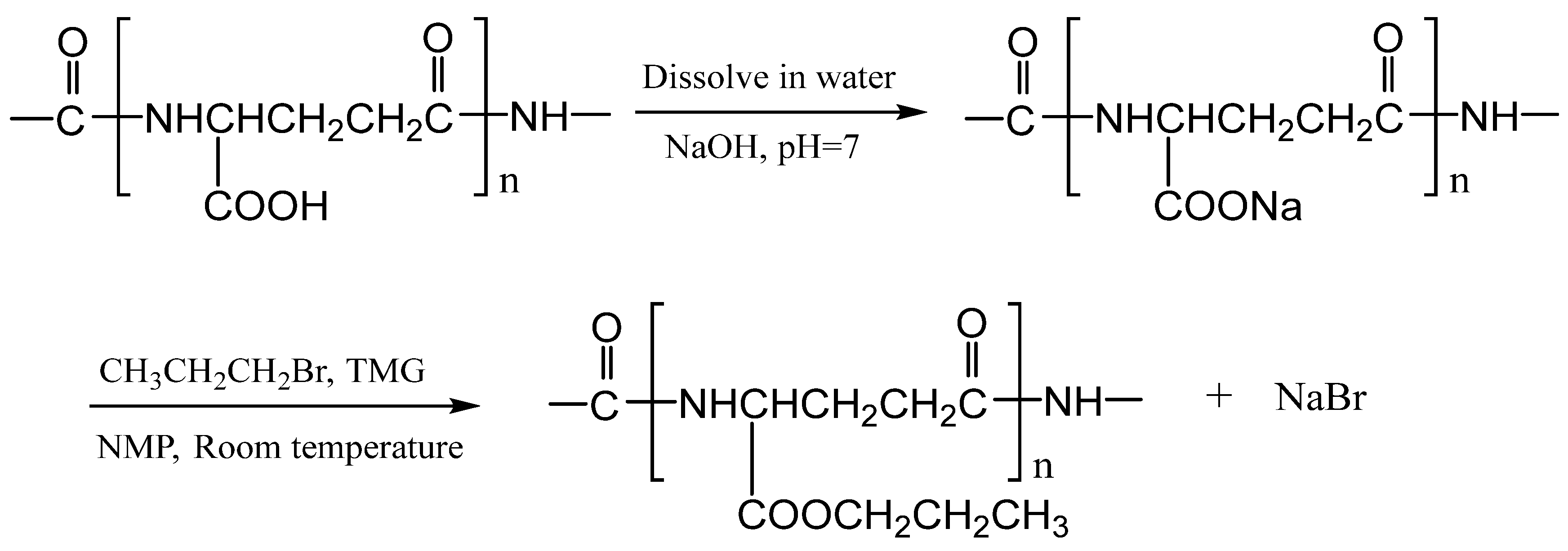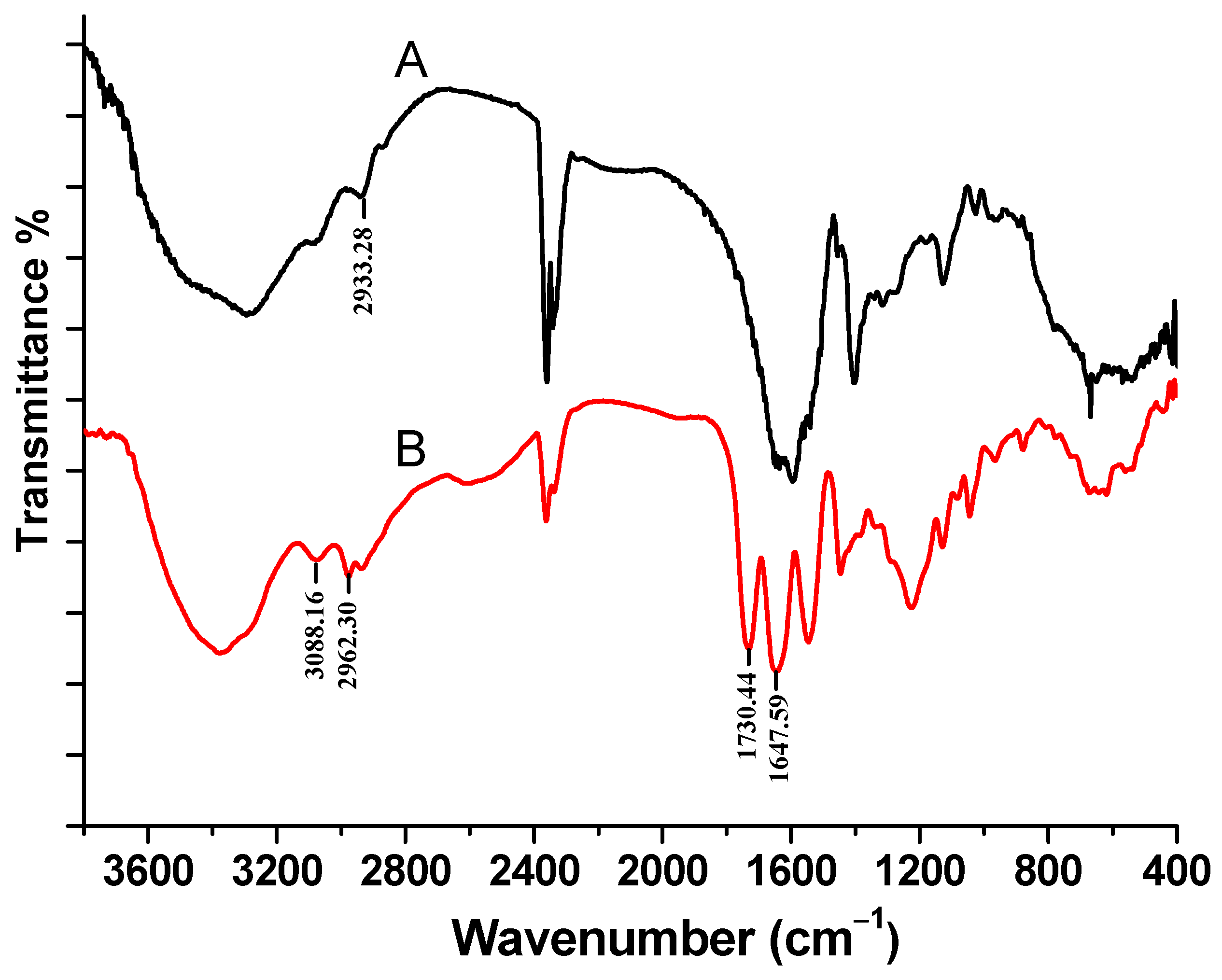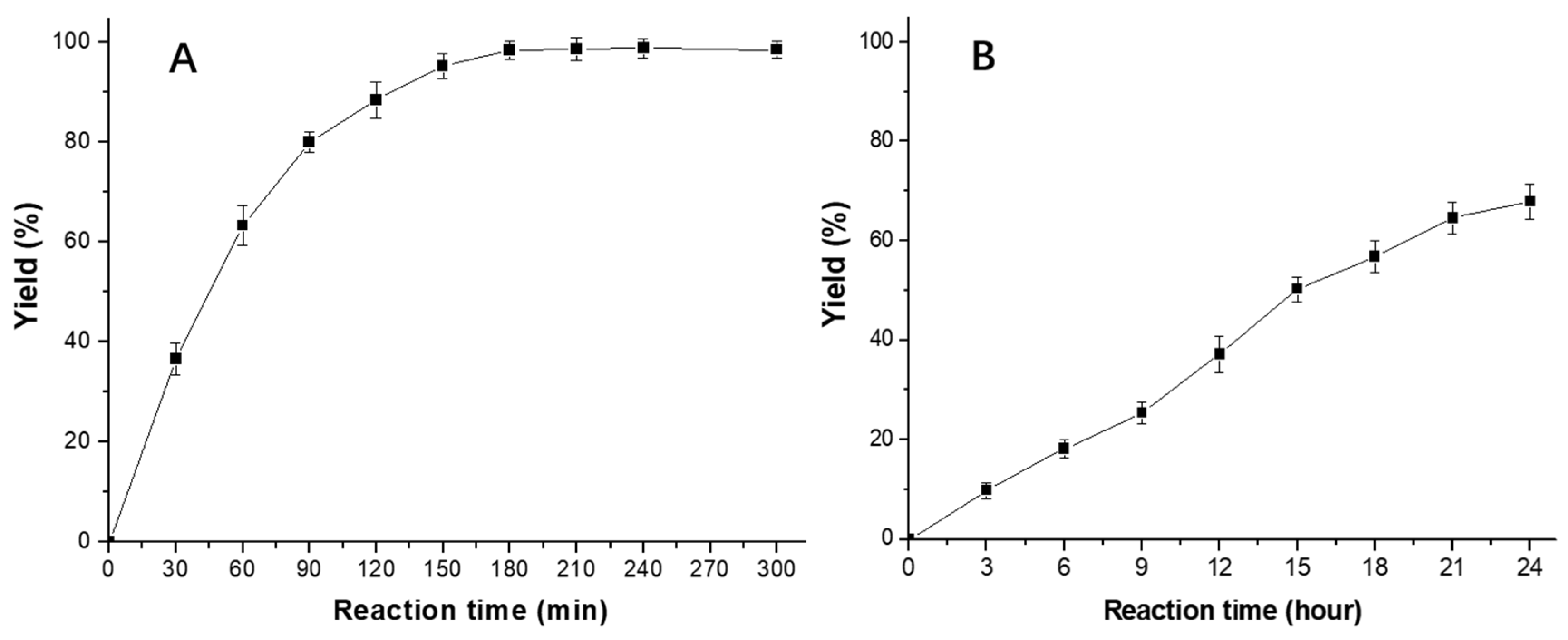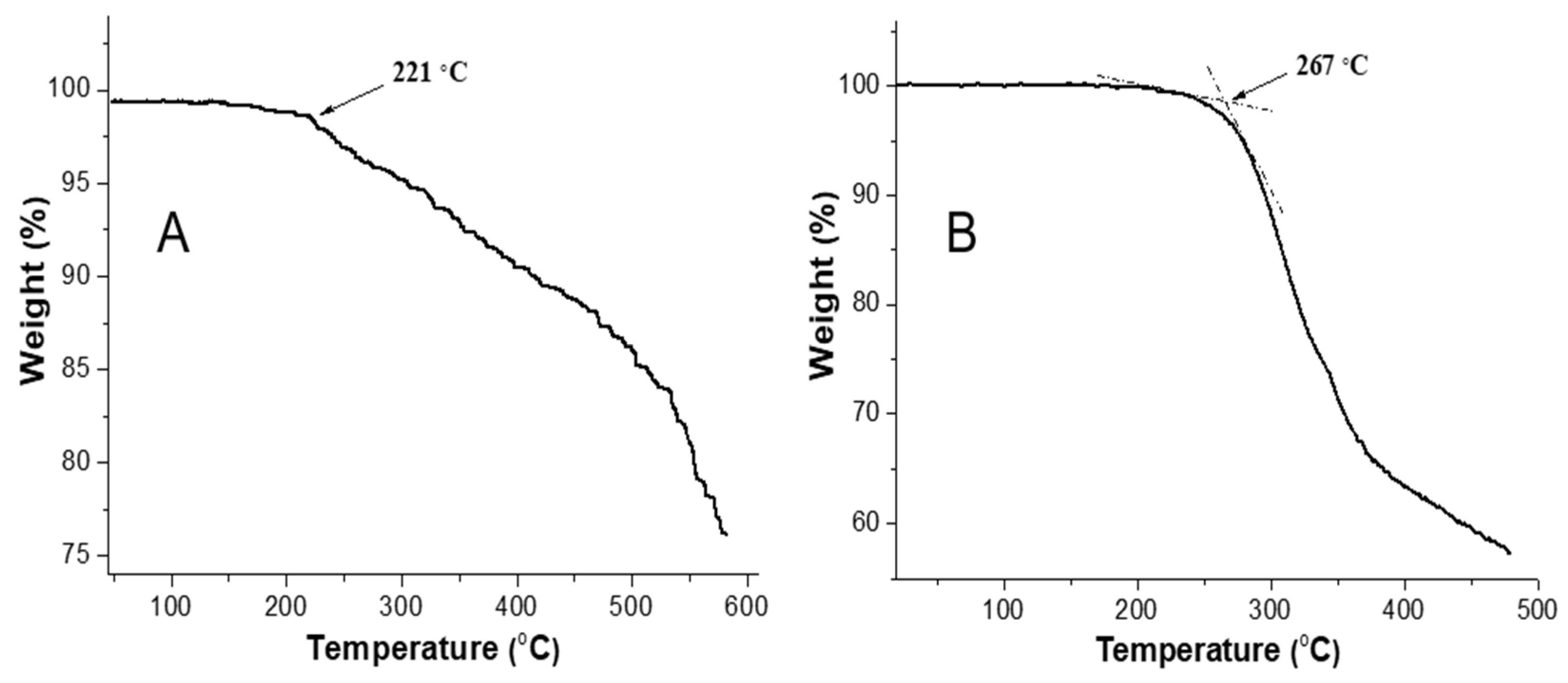A Convenient and Highly Efficient Strategy for Esterification of Poly (γ-Glutamic Acid) with Alkyl Halides at Room Temperature
Abstract
1. Introduction
2. Materials and Methods
2.1. Materials and Measurements
2.2. Preparation of Polyglutamate Sodium
2.3. Procedure of Esterification Reaction
2.4. Measurement of the Yield of Esterification
3. Results and Discussion
3.1. Characterization of the Product of Esterification
3.2. Esterification Kinetics
3.3. Effect of Solvents on Esterification Reaction
3.4. Effect of Halide Structure on Esterification Reaction
3.5. Thermal Stability and Hydrophobic Properties of γ-PGA Propyl Ester
3.6. Evaluation of Esterification Methods
4. Conclusions
Supplementary Materials
Author Contributions
Funding
Institutional Review Board Statement
Data Availability Statement
Conflicts of Interest
References
- Luo, Z.; Guo, Y.; Liu, J.; Qiu, H.; Zhao, M.; Zou, W.; Li, S. Microbial synthesis of poly-gamma-glutamic acid: Current progress, challenges, and future perspectives. Biotechnol. Biofuels 2016, 9, 134–145. [Google Scholar] [CrossRef]
- Cao, M.; Feng, J.; Sirisansaneeyakul, S.; Song, C.; Chisti, Y. Genetic and metabolic engineering for microbial production of poly-gamma-glutamic acid. Biotechnol. Adv. 2018, 36, 1424–1433. [Google Scholar] [CrossRef]
- Zhan, Y.Y.; Sheng, B.J.; Wang, H.; Shi, J.; Cai, D.B.; Yi, L.; Yang, S.H.; Wen, Z.Y.; Ma, X.; Chen, S.W. Rewiring glycerol metabolism for enhanced production of poly-γ-glutamic acid in bacillus licheniformis. Biotechnol. Biofuels 2018, 11, 306–319. [Google Scholar] [CrossRef]
- Wang, D.; Wang, H.; Zhan, Y.Y.; Xu, Y.; Deng, J.; Chen, J.G.; Cai, D.B.; Wang, Q.; Sheng, F.; Chen, S.W. Engineering expression cassette of pgdS for efficient production of poly-γ-glutamic acids with specific molecular weights in bacillus licheniformis. Front. Bioeng. Biotechnol. 2020, 8, 728–738. [Google Scholar] [CrossRef]
- Peng, Y.Y.; Jiang, B.; Zhang, T.; Mu, W.; Ming, M.; Hua, Y. High-level production of poly (γ-glutamic acid) by a newly isolated glutamate-independent strain, Bacillus methylotrophicus. Process Biochem. 2015, 50, 329–335. [Google Scholar] [CrossRef]
- Munoz-Guerra, S.; Melis, J.; Perez-Camero, G.; Bou, J.J.; Congregado, F. Poly (γ-glutamic acid) esters: Synthesis and structure. Polymer Preprints. Polym. Prepr. (Am. Chem. Soc. Div. Polym. Chem.) 1998, 39, 138–139. [Google Scholar]
- Borbély, M.; Nagasaki, Y.; Borbély, J.; Fan, K.; Sevoian, M. Biosynthesis and chemical modification of poly (γ-glutamic acid). Polym. Bull. 1994, 32, 127–132. [Google Scholar] [CrossRef]
- Pérez-Camero, G.; Vázquez, B.; Muñoz-Guerra, S. Water-soluble esters of biosynthetic poly (γ-glutamic acid). J. Appl. Polym. Sci. 2001, 82, 2027–2036. [Google Scholar] [CrossRef]
- Kubota, H.; Fukuda, Y.; Takebe, H.; Endo, T. Poly-γ-Glutamic Acid Ester and Shaped Body Thereof. U.S. Patent 5118784, 2 February 1992. [Google Scholar]
- Kubota, H.; Nambu, Y.; Endo, T. Convenient and quantitative esterification of poly (γ-glutamic acid) produced by microorganism. Polym. Sci. Part A Polym. Chem. 1993, 31, 2877–2878. [Google Scholar] [CrossRef]
- Kubota, H.; Nambu, Y.; Endo, T. Convenient esterification of poly (γ-glutamic acid) produced by microorganism with alkyl halides and their thermal properties. Polym. Sci. Part A Polym. Chem. 1995, 33, 85–88. [Google Scholar] [CrossRef]
- Morillo, M.; Marinez de Ilarduya, A.; Muñoz-Guerra, S. Comblike alkyl esters of biosynthetic poly (γ-glutamic acid). Synthesis and characterization. Macromolecules 2001, 34, 7868–7875. [Google Scholar]
- Melis, J.; Morillo, M.; Martínez de Ilarduya, A.; Muñoz-Guerra, S. Poly (α-alkyl γ-glutamate) of microbial origin: Ester derivatization of poly (γ-glutamic acid) and thermal degradation. Polymer 2001, 42, 9319–9327. [Google Scholar] [CrossRef]
- Flynn, K.G.; Nenortas, D.R. Kinetics and Mechanism of the Reaction between Phenyl Isocyanate and Alcohols. Strong Base Catalysis and Deuterium Isotope Effects. J. Org. Chem. 1963, 28, 3527–3530. [Google Scholar] [CrossRef]
- Ishikawa, T.; Kumamoto, T. Guanidines in organic synthesis. Synthesis 2006, 5, 737–752. [Google Scholar] [CrossRef]
- Leow, D.; Tan, C.H. Chiral guanidine catalyzed enantioselective reactions. Chem.–Asian J. 2009, 4, 488–507. [Google Scholar] [CrossRef]
- Ishikawa, T. Superbases for Organic Synthesis || Index. Chem. Pharm. Bull. 2010, 58, 1555–1564. [Google Scholar] [CrossRef]
- Fu, X.; Tan, C.H. ChemInform Abstract: Mechanistic Considerations of Guanidine-Catalyzed Reactions. Chem. Commun. 2011, 47, 8210–8222. [Google Scholar]
- McBride, A.E.; Cook, J.T.; Stemmler, E.A.; Rutledge, K.L.; McGrath, K.A.; Rubens, J.A. Arginine Methylation of Yeast mRNA-binding Protein Npl3 Directly Affects Its Function, Nuclear Export, and Intranuclear Protein Interactions. J. Biol. Chem. 2005, 280, 30888–30898. [Google Scholar] [CrossRef]
- Mahato, M.; Rana, G.; Kumar, P.; Sharma, A.K. Tetramethylguanidinium-polyallylamine (Tmg-PA): A new class of nonviral vector for efficient gene transfection. J. Polym. Sci. Part A Polym. Chem. 2012, 50, 2344–2355. [Google Scholar] [CrossRef]
- Kocienski, P.J.; Love, C.J.; Whitby, R.J. A Total Synthesis of (±)-Zoapatanol and Demethyl-ORF13811. Tetrahedron 1989, 45, 3839–3848. [Google Scholar] [CrossRef]
- Tanaka, K.; Kamatani, M.; Mori, H.; Fujii, S.; Ikeda, K.; Hisada, M.; Itagaki, Y.; Katsumura, S. Synthesis of a new phospholipase A2inhibitor of an aldehyde terpenoid and its possible inhibitory mechanism. Tetrahedron Lett. 1998, 39, 1185–1188. [Google Scholar] [CrossRef]
- Kocienski, P.J.; Brown, R.C.D.; Pommier, A.; Procter, M.; Schmidt, B. Synthesis of salinomycin. J. Chem. Soc. Perkin Trans. 1998, 1, 9–40. [Google Scholar] [CrossRef]
- Li, Q.B.; Bao, Y.Y.; Wang, H.; Du, F.F.; Li, Q.; Jin, B.K.; Bai, R.K. A facile and highly efficient strategy for esterification of poly(meth)acrylic acid with halogenated compounds at room temperature promoted by 1,1,3,3-tetramethylguanidine. Polym. Chem. 2013, 4, 2891–2897. [Google Scholar] [CrossRef]
- Li, Q.B.; Wang, T.S.; Dai, J.W.; Ma, C.; Jin, B.K.; Bai, R.K. A facile one pot strategy for the synthesis of well-defined polyacrylates from acrylic acid via RAFT polymerization. Chem. Commun. 2014, 50, 3331–3334. [Google Scholar] [CrossRef]
- Li, Q.B.; Wang, T.S.; Ma, C.; Bai, W.; Bai, R.K. Facile and Highly Efficient Strategy for Synthesis of Functional Polyesters via Tetramethyl Guanidine Promoted Polyesterification at Room Temperature. ACS Macro. Lett. 2014, 3, 1161–1164. [Google Scholar] [CrossRef]
- Otto, R.; Brox, J.; Trippe, S.; Stei, M.; Best, T.; Wester, R. Single solvent molecules can affect the dynamics of substitution reactions. Nat. Chem. 2012, 4, 534–538. [Google Scholar] [CrossRef]
- Kornblum, N.; Jones, W.J.; Anderson, G.J. A new and selective method of oxidation. The conversion of alkyl halides and alkyl tosylates to aldehydes. J. Am. Chem. Soc. 1959, 81, 4113–4114. [Google Scholar] [CrossRef]
- Reichardt, C.; Welton, T. Solvents and Solvent Effects in Organic Chemistry, 4th ed.; WILEY-VCH Verlag GmbH & Co. KGaA: Weinheim, Germany, 2011. [Google Scholar]
- Vartiainen, J.; Shen, Y.F.; Kaljunen, T.; Malm, T. Bio-based multilayer barrier films by extrusion, dispersion coating and atomic layer deposition. J. Appl. Polym. Sci. 2015, 133, 1–6. [Google Scholar] [CrossRef]





| Entry | Solvents | Temperature/°C | Time/h | Yield/% |
|---|---|---|---|---|
| 1 | NMP | 30 | 3 | 98.6 ± 0.72 b |
| 2 | DMF | 60 | 19 | 61.3 ± 1.20 |
| 3 | DMSO | 60 | 19 | 68.7 ± 0.71 |
| 4 | DMI | 30 | 3 | 92.8 ± 1.32 |
| 5 | Dichloroethane | 60 | 19 | 23.2 ± 0.97 |
| 6 | Acetonitrile | 60 | 19 | 18.5 ± 0.54 |
| 7 | Water | 30 | 19 | No precipitate |
| Esterification Method | Promoted | Solvent | Reaction Temperature | Reaction Time | Degree of Esterification | Yield | Ref. |
|---|---|---|---|---|---|---|---|
| Direct esterification | TMG | NMP | Room temperature | 3 h | 100% | 98.6% | This work |
| Direct esterification | / | NMP | 60 °C | 19 h | 55% | 73% | [9] |
| Direct esterification | / | NMP | 60 °C | 19 h | 100% | 77.9% | [10] |
| Transesterification | / | DMSO | 180 °C | 10 h | 98% | 90% | [11] |
Disclaimer/Publisher’s Note: The statements, opinions and data contained in all publications are solely those of the individual author(s) and contributor(s) and not of MDPI and/or the editor(s). MDPI and/or the editor(s) disclaim responsibility for any injury to people or property resulting from any ideas, methods, instructions or products referred to in the content. |
© 2024 by the authors. Licensee MDPI, Basel, Switzerland. This article is an open access article distributed under the terms and conditions of the Creative Commons Attribution (CC BY) license (https://creativecommons.org/licenses/by/4.0/).
Share and Cite
Ai, Y.; Zhan, Y.; Cai, D.; Chen, S. A Convenient and Highly Efficient Strategy for Esterification of Poly (γ-Glutamic Acid) with Alkyl Halides at Room Temperature. Polymers 2025, 17, 10. https://doi.org/10.3390/polym17010010
Ai Y, Zhan Y, Cai D, Chen S. A Convenient and Highly Efficient Strategy for Esterification of Poly (γ-Glutamic Acid) with Alkyl Halides at Room Temperature. Polymers. 2025; 17(1):10. https://doi.org/10.3390/polym17010010
Chicago/Turabian StyleAi, Youhong, Yangyang Zhan, Dongbo Cai, and Shouwen Chen. 2025. "A Convenient and Highly Efficient Strategy for Esterification of Poly (γ-Glutamic Acid) with Alkyl Halides at Room Temperature" Polymers 17, no. 1: 10. https://doi.org/10.3390/polym17010010
APA StyleAi, Y., Zhan, Y., Cai, D., & Chen, S. (2025). A Convenient and Highly Efficient Strategy for Esterification of Poly (γ-Glutamic Acid) with Alkyl Halides at Room Temperature. Polymers, 17(1), 10. https://doi.org/10.3390/polym17010010





